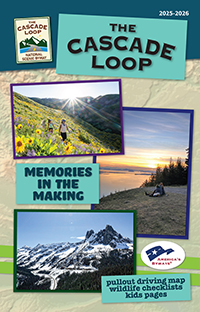California Quail
By Roni Freund

One of the most prevalent birds to be found year-round on the Cascade Loop are the California Quail. These birds are Identified by a topknot, a protruding group of feathers on the top of their head. The male quail (cock) topknot is larger than the female (hen), and it droops forward and shakes when he walks and calls.
Over the years I have observed thousands of quail. During the spring they pair off to mate and nest, then in the summer they feed with their brood, and often a few families (sometimes 30 or 40 birds) will spend the summer months together in what is called a covey. When the weather begins to turn cold, and that years’ chicks are now full adults, the covey grows. All the area families join together and I once stopped count at 100 individuals as they climbed down a hillside, single file. When they reached a ledge, it was like watching water dripping as they jumped down, one at a time, in nearly perfect rhythm.

Adult California Quail weigh about the same as a hockey puck (approximately 5.5 ounces). They have a grey neck and their chest feathers are white with black outlines, giving an appearance similar to a pinecone. The male has a black face, while the female’s face is mottled brown and white. The babies (chicks) are brown downy fluff-balls for a few days, and then they grow like a weed! They can fly at ten days old, and by the end of the summer they are fully grown. The chick pictured was separated from its family on a busy road. We were able to capture it with a towel, and returned it to the family.
Nests of California Quail are usually on the ground, under shrubbery or near a fallen log or brush pile. They are simply a shallow depression in the dirt about 6 inches across, sometimes lined with grass and leaves. When food is plentiful, like my neighborhood in a sagebrush steppe canyon, a female might have more than one brood – not necessarily with the same male. Eggs incubate for about 22 days, and chicks will walk, follow their parents and peck at the ground to feed immediately upon hatching.

They feed mostly on seeds found on the ground, but I have seen an adult male reach as high his short little legs would allow to pull down a weed and eat the seeds from its top.
Watching a communal brood of quail is fascinating if you have the opportunity. One or two males will fly to a perch where they can watch for danger as the others feed and dust bathe through an area. I identify these as “Scouts”. My garden posts are favorites, and the dry dirt patches in my garden become pocked with “bathtub” holes over the season, about 9 inches wide and as much as 6 or 7 inches deep!

The male communicates with a call that sounds like “Shi-KA-Go” (Chicago) and they also have a loud “PIP” when they see danger coming – usually our neighborhood sharp shinned hawk. When the covey gets the signal to flee, they will take off with a loud whir of wings and fly low over the ground to gather at another location.
When they are not feeding, or bathing, they will rest under bushes or sometimes in a tree (like my tree, pictured below, last winter!)
If you are out walking in the snow, you will easily see where a covey of quail has been feeding. They will scratch away the snow to reach seeds on the ground, and their tracks in the snow are distinctive. Here is hoping you will have the chance to watch these wonderful birds in their natural environment!













